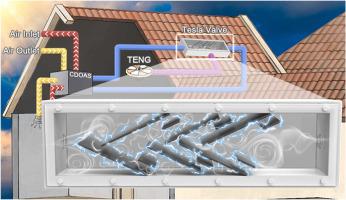当前位置:
X-MOL 学术
›
Nano Energy
›
论文详情
Our official English website, www.x-mol.net, welcomes your
feedback! (Note: you will need to create a separate account there.)
Optimizing photocatalytic performance in an electrostatic-photocatalytic air purification system through integration of triboelectric nanogenerator and Tesla valve
Nano Energy ( IF 16.8 ) Pub Date : 2024-07-04 , DOI: 10.1016/j.nanoen.2024.109965 Xiaoliang Li , Leo N.Y. Cao , Ting Zhang , Rongkun Fang , Yuqing Ren , Xiangyu Chen , Zhenfeng Bian , Hexing Li
Nano Energy ( IF 16.8 ) Pub Date : 2024-07-04 , DOI: 10.1016/j.nanoen.2024.109965 Xiaoliang Li , Leo N.Y. Cao , Ting Zhang , Rongkun Fang , Yuqing Ren , Xiangyu Chen , Zhenfeng Bian , Hexing Li

|
Increasing the collision frequency between gas molecules and photocatalysts can enhance the removal efficiency of volatile organic compounds (VOCs) and particulate matter (PM) in air. In this study, we propose an Electrostatic-Photocatalytic air purification system, containing Tesla valve, triboelectric nanogenerator (TENG), and photocatalysis parts. The incorporation of Ag@ZnO nanorod array (Ag@ZnO-NR) photocatalysts into the internal baffles of the Tesla valve pipeline effectively enhances the collision probability between air pollutant molecules and photocatalysts, and thus facilitating the removal efficiency of pollutants. Additionally, the high-voltage electricity (∼9.0 kV) generated by the TENG facilitates the separation of electron-hole pairs in the photocatalyst, leading to increased production of superoxide radicals (O• − 2 ), hydroxyl radicals (• + ), thereby enhancing the photocatalytic efficiency. In a 1.8 L space system, we achieved an approximately 97 % removal efficiency for toluene within 130 minutes and a similar efficiency for formaldehyde (∼200 ppm) within 175 minutes. Additionally, the PM2.5 concentration rapidly decreased from 999 μg·m−3 to 42 μg·m−3 within 6 minutes, alongside with a significantly faster pollutant removal rate compared to conventional methods. By integrating Tesla valves, TENG, and photocatalysis, this combined system presents an efficient and promising approach for addressing indoor air pollution, with potential applications across various settings.
中文翻译:

通过摩擦纳米发电机和特斯拉阀的集成优化静电光催化空气净化系统中的光催化性能
增加气体分子与光催化剂之间的碰撞频率可以提高空气中挥发性有机化合物(VOC)和颗粒物(PM)的去除效率。在这项研究中,我们提出了一种静电光催化空气净化系统,包含特斯拉阀、摩擦纳米发电机(TENG)和光催化部件。将Ag@ZnO纳米棒阵列(Ag@ZnO-NR)光催化剂融入特斯拉阀门管道内部挡板中,有效增强了空气污染物分子与光催化剂的碰撞概率,从而提高了污染物的去除效率。此外,TENG产生的高压电(∼9.0 kV)有利于光催化剂中电子-空穴对的分离,从而导致超氧自由基(O•−2)、羟基自由基(•OH)和自由基的产生增加。空穴(h+),从而提高光催化效率。在 1.8 L 空间系统中,我们在 130 分钟内实现了约 97% 的甲苯去除效率,并在 175 分钟内实现了类似的甲醛去除效率 (∼200 ppm)。此外,PM2.5浓度在6分钟内从999 μg·m−3迅速下降至42 μg·m−3,污染物去除率明显高于传统方法。通过集成 Tesla 阀门、TENG 和光催化,该组合系统为解决室内空气污染提供了一种有效且有前途的方法,并在各种环境中具有潜在的应用。
更新日期:2024-07-04
中文翻译:

通过摩擦纳米发电机和特斯拉阀的集成优化静电光催化空气净化系统中的光催化性能
增加气体分子与光催化剂之间的碰撞频率可以提高空气中挥发性有机化合物(VOC)和颗粒物(PM)的去除效率。在这项研究中,我们提出了一种静电光催化空气净化系统,包含特斯拉阀、摩擦纳米发电机(TENG)和光催化部件。将Ag@ZnO纳米棒阵列(Ag@ZnO-NR)光催化剂融入特斯拉阀门管道内部挡板中,有效增强了空气污染物分子与光催化剂的碰撞概率,从而提高了污染物的去除效率。此外,TENG产生的高压电(∼9.0 kV)有利于光催化剂中电子-空穴对的分离,从而导致超氧自由基(O•−2)、羟基自由基(•OH)和自由基的产生增加。空穴(h+),从而提高光催化效率。在 1.8 L 空间系统中,我们在 130 分钟内实现了约 97% 的甲苯去除效率,并在 175 分钟内实现了类似的甲醛去除效率 (∼200 ppm)。此外,PM2.5浓度在6分钟内从999 μg·m−3迅速下降至42 μg·m−3,污染物去除率明显高于传统方法。通过集成 Tesla 阀门、TENG 和光催化,该组合系统为解决室内空气污染提供了一种有效且有前途的方法,并在各种环境中具有潜在的应用。











































 京公网安备 11010802027423号
京公网安备 11010802027423号